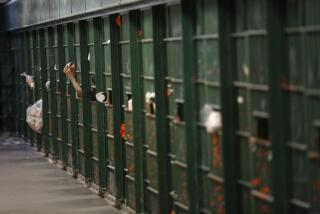Restraint of inmate without food is part of a troubling pattern, sheriff’s watchdog says

L.A. County Sheriff Jim McDonnell on Sunday questioned how an inmate could have been restrained for 32 hours without food or water. “I don’t know how this could go on for this period of time, him not being checked on. Where is the breakdown?”
The recent handcuffing of an inmate without food for 32 hours is part of a troubling pattern of similar mistreatment in the Los Angeles County jails since the beginning of last year, the Sheriff’s Department’s independent civilian watchdog said Sunday.
Inspector General Max Huntsman cited three additional incidents in which inmates were allegedly tethered to objects for prolonged periods.
During one that Huntsman called “particularly humiliating,” an inmate was restrained naked in an area where visitors to the jail could see him. Another at the North County Correctional Facility resulted in 14 jail employees, including nine supervisors, being reassigned to jobs where they had no contact with inmates.
In another case, an inmate was restrained for a long period in a way that was physically uncomfortable, Huntsman said.
The mistreatment of tethered inmates underscores the challenges that Sheriff Jim McDonnell faces in reforming the nation’s largest county jail system, where allegations of deputies brutally beating inmates were once common. Last month, two deputies and their former supervisor were convicted of beating a visitor to the jail while he was handcuffed.
Cameras in the jails, as well as new rules limiting when deputies can use physical force against inmates, have helped make the jails generally less violent. But serious issues remain, including the treatment of mentally ill inmates as well as unruly or violent inmates who are restrained by tethering them.
“It’s pretty clear that the problem is not fixed,” Huntsman said. “There appears to be a pattern, and it isn’t just individual deputies — the problem is more systemic.”
McDonnell, who served on a blue-ribbon commission on jail violence, was elected in November on a reform agenda.
On Sunday, he offered new details about the incident. The inmate, who was booked on an arson charge, was in a medical holding cell June 19 and was identified as suicidal and suffered from mental health problems, McDonnell said. According to preliminary reports, the inmate head-butted a female deputy, who sustained a concussion.
The inmate was then placed in a restraint chair and handcuffed to the chair for about 32 hours, McDonnell said. He received no food and only a single cup of water, though he did receive medical treatment, according to information released by the Sheriff’s Department. Ten jail employees, including three supervisors, were relieved of duty, and a number of others were reassigned.
“I don’t know how this could go on for this period of time, him not being checked on. Where is the breakdown? We’re looking at the system to see how did this possibly occur,” McDonnell said.
A department spokeswoman said Sunday that a new team consisting of two deputies will work 24 hours a day at the Inmate Reception Center, which processes new inmates, to make sure inmates are quickly sent to permanent housing.
With the Inmate Movement Team in place, the inmate restrained June 19 would not have been left for so long, the spokeswoman, Carol Lin, said.
“There is a problem in the L.A. County jails and every jail facility nationally in dealing with those dealing with mental illness,” McDonnell said. “When someone is acting out on their illness, we have to restrain them so they don’t hurt themselves or someone else. The challenge is to do that as humanely as possible.”
Inmates are sometimes tethered when they become violent, refuse to be searched or have been caught with contraband. Handcuffs or other restraining devices such as waist chains are used to tie the inmate to a fixed object such as a chair or a table.
Huntsman said that after the first three tethering incidents, sheriff’s officials drafted new rules that specify how long inmates can be tethered in certain situations. The rules state that supervisors should be involved in the decisions and that tethered inmates should be closely monitored by deputies and video cameras, Huntsman said.
According to department policy, handcuffed inmates should be checked every 15 minutes. Those handcuffed for an extended period “may be” given restroom access and meals.
“When they’re dealing with an inmate who’s not doing what he’s supposed to be doing, they can’t drop the health and safety of the inmate,” Huntsman said. “It can’t be ‘He broke the rules, now I can do whatever the heck I want.’”
Huntsman, who is preparing a report on the tethering issue, is working with sheriff’s officials to refine the rules. He said he is not conducting his own independent investigations because his power to do so is limited. The Sheriff’s Department is investigating each incident internally and has referred the June 19 incident to the FBI.
Huntsman said he is not familiar with further details of the incidents because he does not have access to the department’s internal investigations.
On Friday, sheriff’s officials reminded all Inmate Reception Center employees of the protocols on restraining inmates, feeding them and checking on them. Employees will undergo additional training, the department said.
Huntsman said he was troubled that in some cases, supervisors apparently knew of the tethering and did not stop it.
Derek Hsieh, assistant executive director of the deputies union, also noted the supervisors’ involvement, calling the issues systemic, not individual.
“How do you blame the journeyman when the foreman called the shots? It looks like people may have been following established procedure,” Hsieh said.
From the information released by the Sheriff’s Department about the June 19 incident, it is not clear whether deputies deliberately mistreated the inmate or whether they may have forgotten about him as they worked to process new arrivals in the understaffed, overpopulated jails.
“Did the deputies not know better or were they angry, retaliating?” Huntsman said.
Times staff writer Richard Winton contributed to this report.
More to Read
Sign up for Essential California
The most important California stories and recommendations in your inbox every morning.
You may occasionally receive promotional content from the Los Angeles Times.











